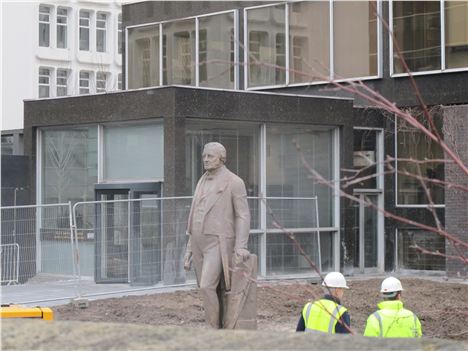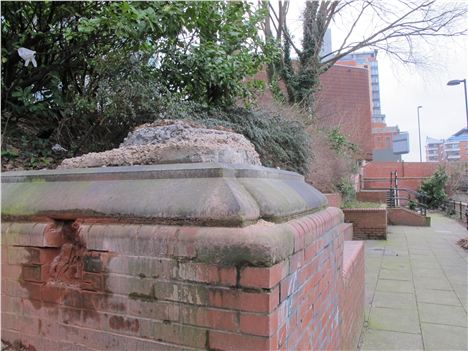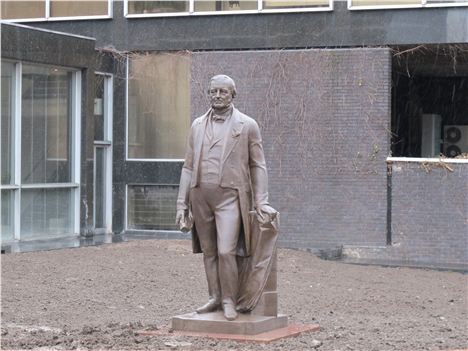Category: Good, Standard or Ugly? Very good (for what it represents rather than for artistic merit)
So what have we here?
It's a statue of Joseph Brotherton
Who sculpted it and when was it erected?
The statue was erected in 1858 and came from the prolific sculptor Matthew Noble.
Why prolific?
It's easy to trip over Matthew Noble statues and busts in Manchester. There’s Prince Albert in Albert Square, the Duke of Wellington in Piccadilly, Cromwell in Wythenshawe Park, Sir Robert Peel in Salford, busts of Victoria, Albert and the engineer Sir Willam Fairbairn in the Town Hall. Manchester made this Yorkshire-born craftsman.
And who is Joseph Brotherton?
Brotherton is definitely one of the good guys. He was born in 1783 as Manchester and Salford were rapidly industrialising and died in 1857 when the cities were fully industrialised and Manchester was the centre of a world economic philosophy, Free Trade.
You said a ‘good guy’
A cotton manufacturer and Salford’s first MP from 1832, Brotherton campaigned against child labour and for improved working conditions in factories. In one debate in Parliament he famously declared that his ‘riches lay not so much in the largeness of his means as in the fewness of his wants’. He was a man who also wanted a better quality of life for working people promoting with great energy the creation of public parks, museums and libraries. He was Salford’s MP for 24 years and was progressive to the core often going much further than his contemporaries.
Go on
He was a pro-Parliamentary reform, anti-war, champion of anti-slavery in first the British Empire and then in the USA, and he considered the death penalty barbaric, campaigning vigorously for its abolition.
He also argued eloquently the case for free non-denominational education which he thought would make people more tolerant of each other and less partisan. He probably would have been appalled by the number of state-funded religious schools we still have 155 years after his death.
He was by conscience a vegetarian, a member of Salford’s small but significant Bible Christian Church. His wife Martha wrote the first widely used vegetarian cookbook from 1812. By the fourth edition it contained over 1200 recipes.
Given all he did for the city it’s a shame that Salford treated his statue so badly.
What do you mean?
The statue has only this year been returned to Salford.
The idiot councillors in 1954 removed him from his proud place in Peel Park, up the road off The Crescent, presumably because they thought the day of Victorian statues was over. Or maybe they were just being particularly insensitive.
This is what the Manchester Guardian wrote about the statue which had been paid for by private individuals (it cost £1,050). It was hoped the statue ‘would remain under the good care of the future authorities of Salford, and that it might ever stand to remind them of the good deeds of him to whose memory it was raised.’ (This quote is taken from Terry Wyke’s superb Public Sculpture of Greater Manchester).
 Brotherton stands in Salford again
Brotherton stands in Salford again
Oh dear, it was a bit naughty to let that slip their minds in 1954
It got worse. Salford Council sold the statue to a private individual in Gawsworth, Macclesfield, who could easily have scrapped it. Manchester City Council bought the statue in the 1980s and placed it in a shockingly maintained riverside walk area gazing across to Salford and the city that had treated his memory so poorly.
But now it’s back on the right side of the river
It is indeed. As part of a larger riverside scheme, Salford are building a connecting path from New Bailey Street to the Lowry Hotel and Trinity Bridge. So at last Joseph Brotherton has been re-erected within the borough he loved so much. Although it must be said that perhaps Manchester's most philanthropic company, Bruntwood, has helped get the statue back across the river and indeed it sits in a corner of their land.
But while the new Salford position for the statue will soon look good, the Manchester bank here is a litter-strewn, crumbling mess, and the plinth that formerly held Brotherton is simply a scar. Let’s hope that joined up thinking wins out and Manchester sorts its side out sooner rather than later. Not that the new position has been maximised?
 The Manchester plinth, rudely mishandled
The Manchester plinth, rudely mishandled
Too modest?
Exactly. Set back. Denied the plinth he had previously. The relocation seems an afterthought, a token gesture. I would have liked him closer to the pavement line and elevated. But more crucially Salford must provide a good potted biography of Brotherton somewhere on a plaque. These dead Victorians need explanation if they are to retain 21st century relevance. There's perhaps a touch of irony to the location as well.
How so?
Brotherton died suddenly and unfortunately. He died on 7 January 1857 on the bus while travelling into Manchester from Pendleton in the company of local bigwigs Sir Thomas Potter and Sir Elkanah Armitage. It’s likely the bus would have passed this spot.
Awful event, but it's nice to think of an MP getting around on public transport. But then Brotherton seems generally a fine example for people in public office. He has his quirks though.
Pole-dancing?
Maybe, not sure. But Noble’s statue touchingly displays a buttonhole carrying a flower. Brotherton wore a fresh flower every day as a symbol of his belief in the potential of his fellow Man, the beauty of Nature and the swift passing of life. Carpe Diem folks. Gather ye rosebuds whilst ye may... Joseph Brotherton it would appear didn't waste a second of his 74 years.
You can follow Jonathan Schofield on Twitter here @JonathSchofield
















